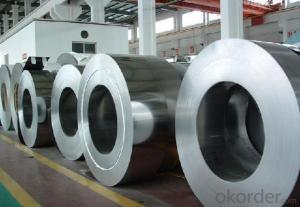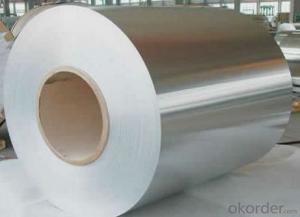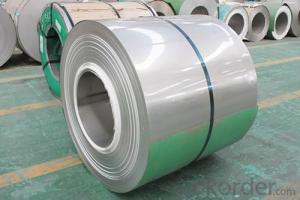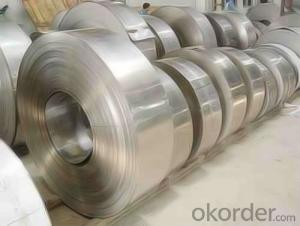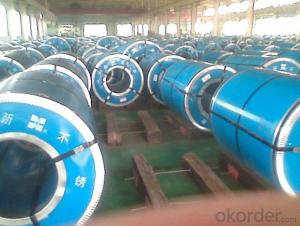HONGRI stainless steel coil with high quality 310s ba
- Loading Port:
- Guangzhou
- Payment Terms:
- TT OR LC
- Min Order Qty:
- 20 m.t.
- Supply Capability:
- 500 m.t./month
OKorder Service Pledge
OKorder Financial Service
You Might Also Like
Product name | 310s ba stainless steel coil with high quality |
Specification | Thickness: Cold rolled: 0.3-3mm, Hot Rolled: 3-120mm Width: 500-2000mm Length: 1000-6000mm Customized sizes are accepted |
Standard | ASME, ASTM, EN, BS, GB, DIN, JIS, etc |
Finish | NO.1, NO.4, 2B, BA, HL, 8K, Mirror finish and so on |
Material | 201, 202, 304, 304L, 310S, 316, 316L, 410, 420, 430, 441, 800H, 904L |
Brand Name | HONGRI |
Place of Origin | Jiangsu of China (Mainland) |
Technical treatment | Cold Rolled, Hot Rolled |
MOQ | 20 Metric Ton |
Port of Loading | GUANGZHOU |
Terms of Delivery | FOB, CFR, CIF, CNF, EXWORK |
Terms of Payment | L/C, T/T (30% desipot) |
Packing | Standard export sea-worthy packing |
Delivery time | Within 7days after recieve 30% desipot or as your requirement |
Stock | Ready in stocks |
310s ba stainless steel coil with high quality
Grade | C ≤ | Si ≤ | Mn ≤ | P ≤ | S ≤ | Ni ≤ | Cr ≤ |
201 | 0.12 | 0.75 | 7.00 | 0.045 | 0.045 | 1.00-1.28 | 13.70-15.70 |
202 | 0.15 | 1.00 | 2.25 | 0.045 | 0.045 | 4.07-4.17 | 14.00-16.00 |
304 | 0.08 | 0.75 | 2.00 | 0.045 | 0.03 | 8.00-11.00 | 18.00-20.00 |
304L | 0.035 | 0.75 | 2.00 | 0.045 | 0.03 | 8.00-13.00 | 18.00-20.00 |
309 | 0.15 | 0.75 | 2.00 | 0.045 | 0.03 | 12.00-15.00 | 22.00-24.00 |
310S | 0.08 | 1.50 | 2.00 | 0.045 | 0.03 | 19.00-22.00 | 24.00-26.00 |
316 | 0.08 | 1.00 | 2.00 | 0.045 | 0.03 | 10.00-14.00 | 16.00-18.00 |
316L | 0.035 | 0.75 | 2.00 | 0.045 | 0.03 | 10.00-15.00 | 16.00-18.00 |
321 | 0.04-0.10 | 0.75 | 2.00 | 0.045 | 0.03 | 9.00-13.00 | 17.00-20.00 |
405 | 0.08 | 0.75 | 1.00 | 0.045 | 0.03 | 0.06 | 11.5-13.5 |
409 | 0.089 | 1.00 | 1.00 | 0.045 | 0.05 | 0.06 | 10.50-11.75 |
410 | 0.15 | 0.75 | 1.00 | 0.045 | 0.03 | 0.06 | 11.5-13.5 |
420 | 0.16-0.25 | 1.00 | 1.00 | 0.040 | 0.03 | 0.06 | 12.00-14.00 |
430 | 0.12 | 0.75 | 1.00 | 0.045 | 0.03 | 0.06 | 16.00-18.00 |
904L | 0.02 | 1.0 | 2.00 | 0.045 | 0.03 | 23.00-28.00 | 19.00-23.00 |
Finishings
| Surface | Definition | Application |
| NO.1 | The surface finished by heat treatment and pickling or processes corresponding there to after hot rolling. | Chemical tank, pipe. |
| 2B | Those finished, after cold rolling, by heat treatment, pickling or other equivalent treatment and lastly by cold rolling to given appropriate luster. | Medical equipment, Food industry, Construction material, Kitchen utensils. |
NO.3 | Those finished by polishing with No.100 to No.120 abrasives specified in JIS R6001. | Kitchen utensils, Building construction |
NO.4 | Those finished by polishing with No.150 to No.180 abrasives specified in JIS R6001. | Kitchen utensils, Building construction, Medical equipment. |
HL | Those finished polishing so as to give continuous polishing streaks by using abrasive of suitable grain size | Building Construction. |
BA (No.6) | Those processed with bright heat treatment after cold rolling.
| Kitchen utensils, Electric equipment, Building construction. |
Mirror (No.8) | Shinning like a mirror | Building construction |
- Q:Can 111 stainless steel strips be hardened through heat treatment?
- Yes, 111 stainless steel strips can be hardened through heat treatment. Stainless steel strips are typically heat treated to enhance their mechanical properties, such as hardness and strength. The heat treatment process involves heating the steel strips to a specific temperature, known as the austenitizing temperature, and then cooling them rapidly, known as quenching. This quenching process helps to transform the austenitic structure of the steel into a martensitic structure, which is harder and more durable. After quenching, the steel strips may undergo further tempering, which involves reheating the steel to a lower temperature to reduce its brittleness and improve its toughness. Overall, heat treatment is an effective method to harden stainless steel strips, including those made of 111 stainless steel.
- Q:What are the different types of surface defects in stainless steel strips?
- There are several types of surface defects that can occur in stainless steel strips, including scratches, pits, dents, stains, and discoloration. These defects can occur during manufacturing, handling, or due to environmental factors. It is important to identify and address these defects to ensure the quality and performance of the stainless steel strips.
- Q:What is the electrical conductivity of stainless steel strips?
- The electrical conductivity of stainless steel strips may vary depending on the specific type and composition of stainless steel. In general, stainless steel is not as conductive as metals such as copper or aluminum. This is mainly due to stainless steel's higher resistance to the flow of electric current. However, there are stainless steel alloys that have been specially formulated to improve electrical conductivity. These alloys often contain higher amounts of elements like nickel or copper, which enhance the material's conductivity. It is important to consider that factors like temperature, surface condition, and strip thickness can also affect the electrical conductivity of stainless steel. Therefore, it is recommended to refer to specific data or consult with manufacturers to obtain accurate information regarding the electrical conductivity of stainless steel strips.
- Q:Can stainless steel strips be magnetized?
- Stainless steel strips can indeed be magnetized. Although stainless steel is typically regarded as non-magnetic, certain varieties of stainless steel can display magnetic characteristics under specific circumstances. The magnetic attributes of stainless steel are influenced by factors such as its chemical composition, heat treatment, and manufacturing process. The most commonly found type of stainless steel, known as austenitic stainless steel, is generally non-magnetic. Nevertheless, it can acquire a slight magnetic quality when subjected to cold working or deformation, as is the case with stainless steel strips. Conversely, ferritic and martensitic stainless steels possess magnetism in their annealed or hardened state. These particular types of stainless steel strips can be easily magnetized and retain their magnetism even after the external magnetic field is no longer present. Consequently, it is crucial to take into account the specific type of stainless steel strip in order to determine its magnetic properties.
- Q:Are stainless steel strips suitable for oil and gas applications?
- Yes, stainless steel strips are suitable for oil and gas applications. Stainless steel offers excellent resistance to corrosion, making it highly suitable for use in oil and gas environments where exposure to corrosive substances is common. Additionally, stainless steel strips have high strength and durability, allowing them to withstand the harsh conditions and pressures often found in oil and gas operations. They also have good heat resistance and can maintain their mechanical properties at both high and low temperatures. These properties make stainless steel strips ideal for a wide range of applications in the oil and gas industry, including pipelines, storage tanks, and offshore platforms.
- Q:Which material is better, stainless steel or belt?
- Summer is the best with a stainless steel belt, the belt in the summer after the sweat corrosion, there will be an unpleasant smell, easily broken; stainless steel material is relatively good, generally not bad, summer with sweat also nothing, no taste. I hope my answer will be helpful to you!
- Q:Can 111 stainless steel strips be used in the construction industry?
- The construction industry can utilize 111 stainless steel strips. Stainless steel, which is known for its versatility and durability, is commonly used in various construction applications. Its ability to resist corrosion makes it suitable for both indoor and outdoor projects. Stainless steel strips have multiple uses in the construction industry, including cladding, roofing, wall panels, and architectural features. Moreover, its strength and ability to withstand extreme temperatures make it an excellent choice for structural components like beams, columns, and supports. However, it is essential to consider the specific grade of stainless steel, such as 111, as it may have different mechanical properties that could affect its suitability for specific applications. Consulting with a structural engineer or construction professional is crucial to ensuring that 111 stainless steel strips meet the required specifications for a particular project.
- Q:What are the common industry standards for stainless steel strips?
- The stainless steel industry adheres to different standards for stainless steel strips depending on the specific application and requirements. Numerous recognized standards are commonly followed by manufacturers and users in the industry. The American Society for Testing and Materials (ASTM) standard, in particular, is widely referenced. ASTM A666/A666M outlines the standard specification for annealed or cold-worked austenitic stainless steel strips. This specification includes details on the chemical composition, mechanical properties, and dimensional tolerances of these materials. Furthermore, the International Organization for Standardization (ISO) has developed multiple standards related to stainless steel strips. ISO 9445 specifies tolerances on dimensions and form for continuously cold-rolled stainless steel narrow strips, while ISO 9444 provides general requirements for preparing steel substrates before applying paints and related products. In Europe, the European Committee for Standardization (CEN) has established the EN standards for stainless steel strips. EN 10151 outlines the technical delivery conditions for cold-rolled stainless steel strips used for springs, while EN 10088-2 covers the technical delivery conditions for stainless steel strips used for general purposes. In addition to these widely recognized standards, certain sectors may follow industry or application-specific standards. These standards may include additional requirements or specifications based on the intended use of stainless steel strips, such as in the automotive, construction, or medical industries. It is crucial for manufacturers and users to be aware of the relevant industry standards and ensure compliance with them. This ensures the quality, performance, and compatibility of stainless steel strips in their specific applications.
- Q:How do you clean stainless steel strips?
- To clean stainless steel strips, you can start by wiping them down with a soft cloth or sponge soaked in warm soapy water. For tougher stains or dirt buildup, you can use a non-abrasive cleaner specifically formulated for stainless steel. It's important to avoid using abrasive materials or harsh chemicals as they can damage the surface. After cleaning, make sure to rinse the strips thoroughly with water and dry them with a clean cloth to prevent water spots or streaks.
- Q:What are the physical properties of stainless steel strips?
- Stainless steel strips have become a favored choice in many industries due to their distinct physical properties. To begin with, they are renowned for their durability and strength. This material possesses exceptional tensile strength, enabling it to withstand heavy loads and resist deformation or breakage. Another key physical property of stainless steel strips is their resistance to corrosion. They are specifically engineered to resist oxidation and corrosion, rendering them ideal for applications involving exposure to moisture, chemicals, or harsh environments. Even in corrosive conditions, stainless steel strips can maintain their integrity and appearance, reducing the need for frequent maintenance or replacement. Furthermore, stainless steel strips boast a high melting point, contributing to their overall strength and heat resistance. This characteristic makes them well-suited for applications involving high temperatures, such as those found in the automotive, aerospace, or manufacturing industries. Additionally, stainless steel strips exhibit excellent conductivity. They can efficiently conduct heat and electricity, making them suitable for applications that require efficient heat transfer or electrical conduction, such as in the construction of appliances, electrical enclosures, or heat exchangers. Moreover, stainless steel strips possess a visually appealing appearance due to their smooth and lustrous surface. This quality makes them highly sought after in architectural and decorative applications where aesthetics play a crucial role. In conclusion, the physical properties of stainless steel strips, including their strength, corrosion resistance, high melting point, excellent conductivity, and visually appealing appearance, make them versatile and widely utilized in various industries, including construction, automotive, aerospace, and manufacturing.
1. Manufacturer Overview |
|
|---|---|
| Location | |
| Year Established | |
| Annual Output Value | |
| Main Markets | |
| Company Certifications | |
2. Manufacturer Certificates |
|
|---|---|
| a) Certification Name | |
| Range | |
| Reference | |
| Validity Period | |
3. Manufacturer Capability |
|
|---|---|
| a)Trade Capacity | |
| Nearest Port | |
| Export Percentage | |
| No.of Employees in Trade Department | |
| Language Spoken: | |
| b)Factory Information | |
| Factory Size: | |
| No. of Production Lines | |
| Contract Manufacturing | |
| Product Price Range | |
Send your message to us
HONGRI stainless steel coil with high quality 310s ba
- Loading Port:
- Guangzhou
- Payment Terms:
- TT OR LC
- Min Order Qty:
- 20 m.t.
- Supply Capability:
- 500 m.t./month
OKorder Service Pledge
OKorder Financial Service
Similar products
New products
Hot products
Hot Searches
Related keywords

